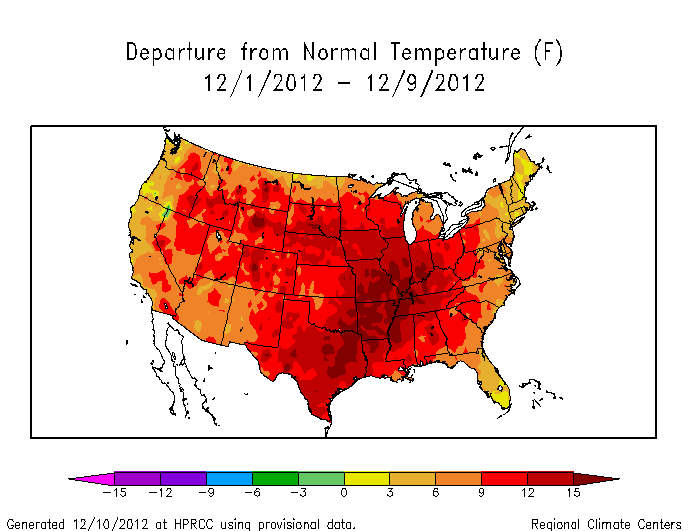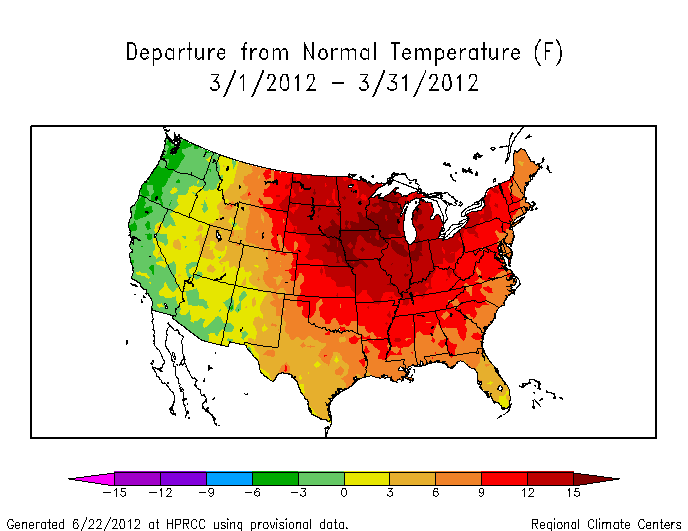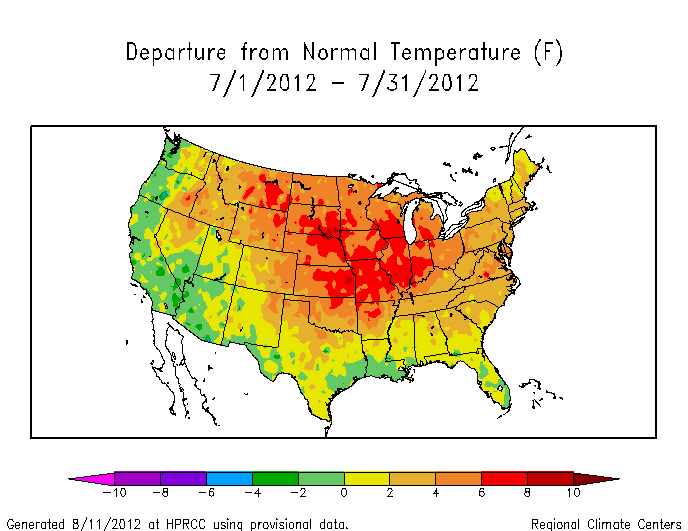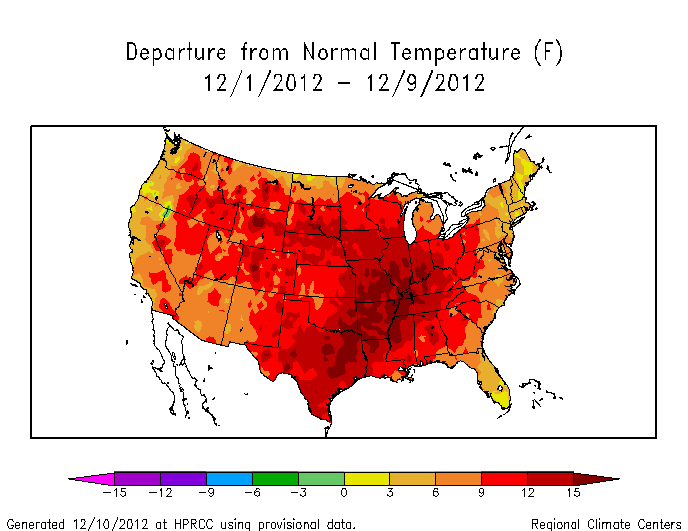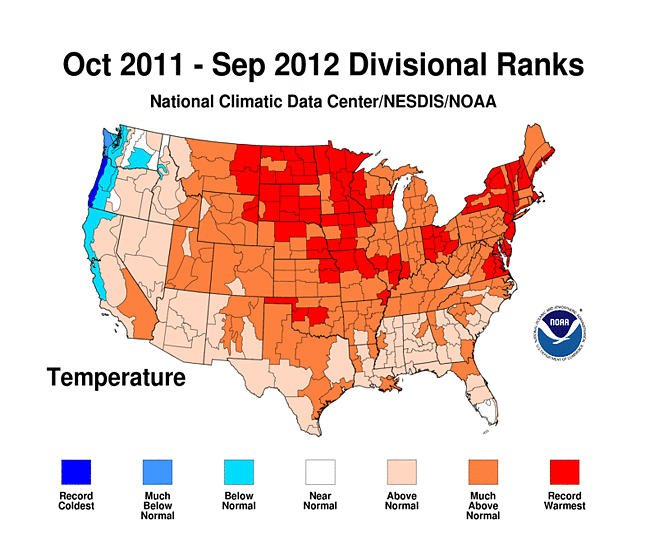The first months of 2013 here in Charlotte have seemed unusually cool, but rather than relying on our gut feeling, let’s look at the numbers. Start by going to the NCDC website and mine out the data to find that in Charlotte, January was the 27th warmest in 118 years, February was the 40th coolest, and March was the 4th coldest in 118 years. Now a fair second question is how does Charlotte fit into the big picture? Namely, is Charlotte’s temperature ranking similar to that of the whole state of North Carolina, the USA, and even the world? With only a little bit of work, we can figure this out. The data below shows temperature anomaly compared to the 20th Century average as a +/- number, and the parenthetical numbers are the ranking in the overall temperature record (1 is hottest). USA has 119-120 years of data, while the global time series begins in 1880.
Charlotte* North Carolina USA** Global Land Global***
April 2012 +1.7 (31) +1.1 (39) +3.7 (3) +1.1 (6) +0.6 (7)
May 2012 +2.9 (13) +2.9 (11) +3.3 (2) ? (7) +0.5 (10)
June 2012 -1.5 (93) -1.5 (98) +2.0 (12) +0.9 (4) +0.6 (7)
July 2012 +2.4 (8) +3.2 (2) +3.3 (1) +0.8 (5) +0.6 (7)
August 2012 -1.3 (97) -0.4 (69) +1.7 (13) +0.8 (2) +0.6 (8)
September 2012 -1.6 (83) -0.9 (72) +1.4 (23) +0.9 (4) +0.5 (8)
October 2012 -1.5 (81) -0.6 (65) -0.3 (73) +1.1 (2) +0.6 (8)
November 2012 -3.6 (109) -3.6 (108) +2.0 (20) +1.1 (6) +0.7 (5)
December 2012 +5.1 (8) +5.5 (8) +3.3 (10) +0.2 (49) +0.4 (18)
January 2013 +2.8 (27) +3.5 (24) +1.5 (42) +0.9 (13) +0.5 (9)
February 2013 -2.0 (80) -0.8 (70) +0.9 (49) +1.0 (11) +0.6 (9)
March 2013 -6.7 (116) -5.9 (114) -0.8 (77) +1.1 (11) +1.0 (10)
What’s remarkable is that at first glance, it seems like the rankings of Charlotte and NC are essentially on the opposite end of the spectrum of rankings compared to the global rankings in the last 12 months. There’s an easy way to quantitatively evaluate the relationship between sets of numbers and that is by using the statistical correlation coefficient, usually represented by the variable r. A positive r value means the numbers go up and down together, while a negative r means one set of numbers go up while the other goes down. When r is +1 or -1, that means the two sets of numbers are perfectly correlated and perfectly anti-correlated, respectively. Perfect correlation or anti-correlation never happens with data, unless you calculate the correlation of a dataset against itself which isn’t very interesting. That being said, r near +1 or -1 usually indicates that the two datasets being compared are statistically related. To quantify “usually” from the previous sentence and to contextualize the r value, a corresponding statistic that accompanies r is the p value. The p value is a way to quantify the statistical significance of the r value and depends. A p value less than 0.05 means there’s a 95% chance that a random set of numbers is not better related than the numbers you are testing. Thus when p is less than 0.05, you can be confident there is “statistically significant” relationship – remembering that correlation does not imply causation. This kind of analysis is done all the time in all fields of science, which speaks to the idea that math is the universal language. In the table below, r is the +/- number, p is the parenthetical number.
NC USA Global Land Global
Charlotte +0.97 (<0.05) +0.52 (0.08) -0.43 (0.16) -0.43 (0.16)
NC - +0.48 (0.11) -0.39 (0.21) -0.44 (0.16)
USA - - -0.10 (0.77) +0.002 (0.99)
Global Land - - - +0.92 (<0.05)
Now we’re getting somewhere. Over the last 12 months, Charlotte and NC temperatures are, as expected, significantly correlated (r = +0.97, p < 0.05). If Charlotte sets a cold or warm record, so does NC. Global land and ocean ("global" in the table) and global land are significantly correlated (+0.92, p < 0.05) as well. Not that shocking. What I didn't expect until I started comparing the trend in the rankings is that NC and Charlotte rankings are not significantly related to the USA or global temperature rankings. This is evident by the high p values in parenthesis in the 1st and 2nd rows. Surprisingly, NC and Charlotte are nearly significantly anti-correlated (negative r values, see above) with global rankings, something that might be worth looking into with more data. What’s perhaps even more surprising to me is that USA temperature rankings are essentially unrelated to the either of the global temperature rankings. This means that any given month in the USA tells you absolutely nothing about the global ranking for the same month – you might as well just guess. More data will tell the a more complete story here (and provide better stats), but over the last 12 months, there are some interesting possible relationships (Charlotte and NC similar to the USA, but opposite of the globe), and then occasions where the two datasets have no idea the other exists (USA and the globe). No wonder people get mixed up when looking at the news about global warming and then try to relate it to what’s going on in their backyard.
